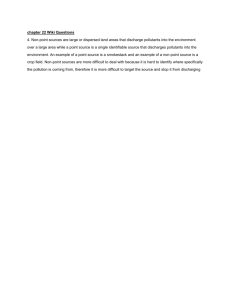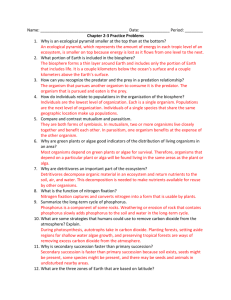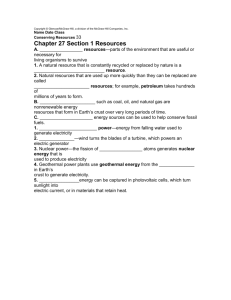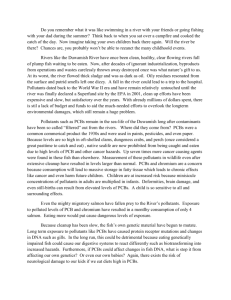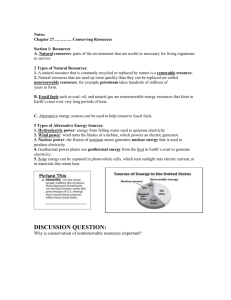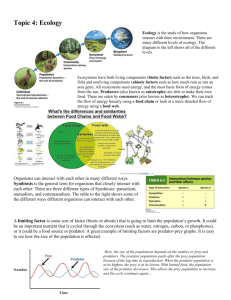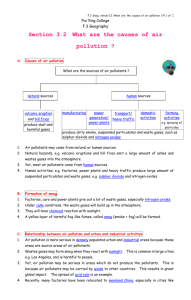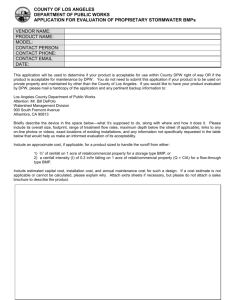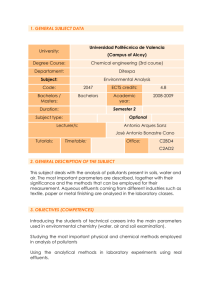Water Pollutants - FIU Faculty Websites
advertisement
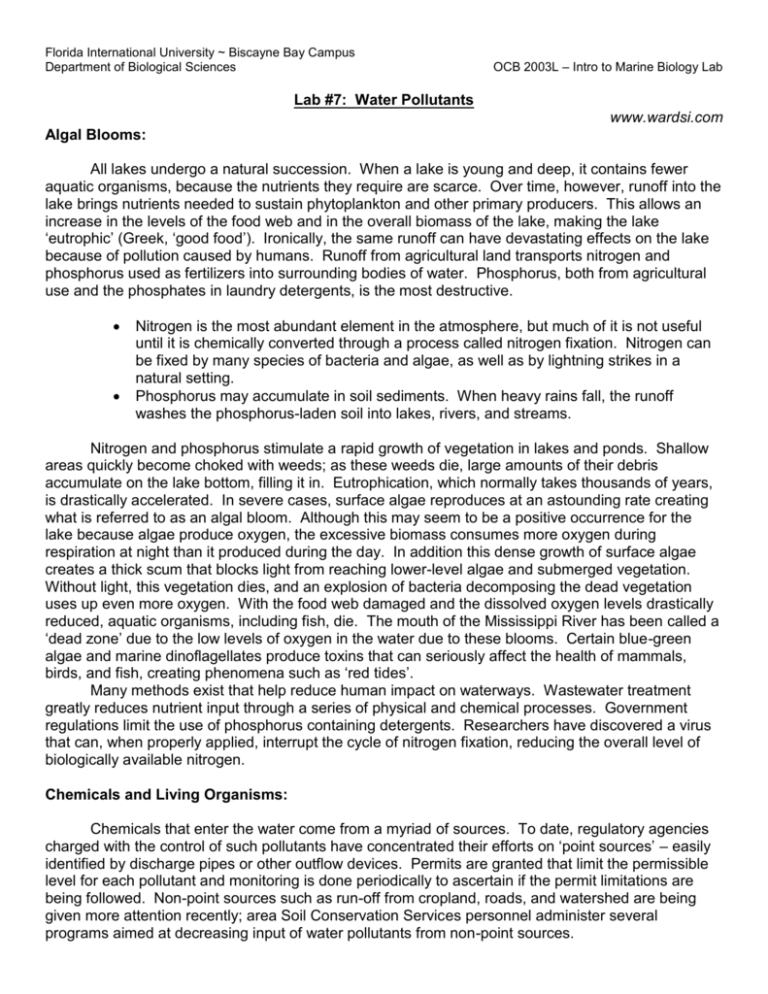
Florida International University ~ Biscayne Bay Campus Department of Biological Sciences OCB 2003L – Intro to Marine Biology Lab Lab #7: Water Pollutants www.wardsi.com Algal Blooms: All lakes undergo a natural succession. When a lake is young and deep, it contains fewer aquatic organisms, because the nutrients they require are scarce. Over time, however, runoff into the lake brings nutrients needed to sustain phytoplankton and other primary producers. This allows an increase in the levels of the food web and in the overall biomass of the lake, making the lake ‘eutrophic’ (Greek, ‘good food’). Ironically, the same runoff can have devastating effects on the lake because of pollution caused by humans. Runoff from agricultural land transports nitrogen and phosphorus used as fertilizers into surrounding bodies of water. Phosphorus, both from agricultural use and the phosphates in laundry detergents, is the most destructive. Nitrogen is the most abundant element in the atmosphere, but much of it is not useful until it is chemically converted through a process called nitrogen fixation. Nitrogen can be fixed by many species of bacteria and algae, as well as by lightning strikes in a natural setting. Phosphorus may accumulate in soil sediments. When heavy rains fall, the runoff washes the phosphorus-laden soil into lakes, rivers, and streams. Nitrogen and phosphorus stimulate a rapid growth of vegetation in lakes and ponds. Shallow areas quickly become choked with weeds; as these weeds die, large amounts of their debris accumulate on the lake bottom, filling it in. Eutrophication, which normally takes thousands of years, is drastically accelerated. In severe cases, surface algae reproduces at an astounding rate creating what is referred to as an algal bloom. Although this may seem to be a positive occurrence for the lake because algae produce oxygen, the excessive biomass consumes more oxygen during respiration at night than it produced during the day. In addition this dense growth of surface algae creates a thick scum that blocks light from reaching lower-level algae and submerged vegetation. Without light, this vegetation dies, and an explosion of bacteria decomposing the dead vegetation uses up even more oxygen. With the food web damaged and the dissolved oxygen levels drastically reduced, aquatic organisms, including fish, die. The mouth of the Mississippi River has been called a ‘dead zone’ due to the low levels of oxygen in the water due to these blooms. Certain blue-green algae and marine dinoflagellates produce toxins that can seriously affect the health of mammals, birds, and fish, creating phenomena such as ‘red tides’. Many methods exist that help reduce human impact on waterways. Wastewater treatment greatly reduces nutrient input through a series of physical and chemical processes. Government regulations limit the use of phosphorus containing detergents. Researchers have discovered a virus that can, when properly applied, interrupt the cycle of nitrogen fixation, reducing the overall level of biologically available nitrogen. Chemicals and Living Organisms: Chemicals that enter the water come from a myriad of sources. To date, regulatory agencies charged with the control of such pollutants have concentrated their efforts on ‘point sources’ – easily identified by discharge pipes or other outflow devices. Permits are granted that limit the permissible level for each pollutant and monitoring is done periodically to ascertain if the permit limitations are being followed. Non-point sources such as run-off from cropland, roads, and watershed are being given more attention recently; area Soil Conservation Services personnel administer several programs aimed at decreasing input of water pollutants from non-point sources. Florida International University ~ Biscayne Bay Campus Department of Biological Sciences OCB 2003L – Intro to Marine Biology Lab Because of the phenomenon known as ‘biological magnification,’ water containing levels of pollutants so low that the water is deemed ‘potable’ – or fit to drink – can still be a source of problems. For example, large long-lived fish have been found to have a concentration of PCB that is ten million times greater than the water concentration of PCB. Two characteristics of the PCBs make them likely candidates for biological magnification. First, the PCBs are difficult for biological processes to degrade to harmless products; the bacteria and other organisms that usually accomplish these tasks lack the necessary enzymes to handle such man-made materials. Because they were never exposed to such chemicals before, they did not evolve the enzymatic capability to process these exotic substances. Second, the PCBs are fat-soluble so they concentrate in the fat tissue of an organism and are not flushed out with the water-soluble compounds. Thus, during an organism’s lifetime, the fat tissue increases its concentration of the chemical and this concentrated chemical is passed onto the organisms in the next level of the food chain. As this continues up the food chain, the final consumer retains a remarkably high concentration of the chemical in its body fat. Thus water that is safe to drink can be the home to fishes that greatly exceed levels for such fat-soluble compounds that are considered acceptable for human consumption. The FDA recently lowered the acceptable level of PCBs in commercial fish from 5 ppm to only 2 ppm (parts per million). Metallic ions may enter the circulatory system of a fish directly from the water by gill uptake. Active transport of the necessary minerals from the water may simultaneously result in the absorption of toxic ions that mimic the required metallic ions. Water pollutants frequently show the phenomenon of positive synergy; this occurs when two pollutants which have little effect when encountered alone, combine to multiply each other’s effects on a living organism with dramatic results. Regulatory agencies must be aware of the positive synergy effects that may be shown by the water pollutants listed on the permits they issue to a discharger; they must consider the overall, combined effects of these chemicals or the organisms in the receiving waters will be in peril. The effects of water pollutants on different kinds of organisms are frequently shown on our television and in our printed media. However, it is rare that a student has the opportunity to directly view the effects of various water pollutants in the laboratory. The exercises in today’s lab allows students to witness a living organism’s response to six different water pollutants and then to compare its responses to various combinations of these pollutants. The phenomenon of positive synergy warns us that the effects of pollutants can multiply—not merely add together—when they are mixed. The living organism used in the exercise, Turbatrix aceti or the vinegar eel, is a rapid swimmer until the effects of the pollutant take over. Then its ability to maintain directional motion is lessened, its coordination begins to fail and it frequently makes loops of its long, cylindrical body.


